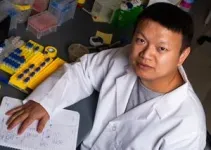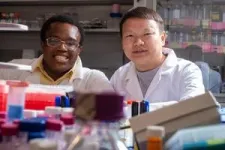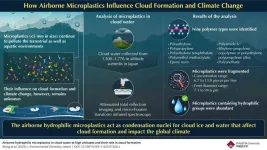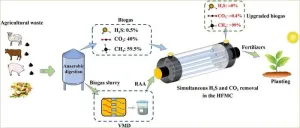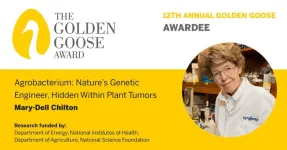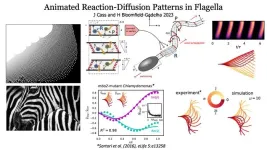(Press-News.org) HOUSTON – (Sept. 27, 2023) Small and precise: These are the ideal characteristics for CRISPR systems, the Nobel-prize winning technology used to edit nucleic acids like RNA and DNA.
Rice University scientists have described in detail the three-dimensional structure of one of the smallest known CRISPR-Cas13 systems used to shred or modify RNA and employed their findings to further engineer the tool to improve its precision. According to a study published in Nature Communications, the molecule works differently than other proteins in the same family.
“There are different types of CRISPR systems, and the one our research was focused on for this study is called CRISPR-Cas13bt3,” said Yang Gao, an assistant professor of biosciences and Cancer Prevention and Research Institute of Texas Scholar who helped lead the study. “The unique thing about it is that it is very small. Usually, these types of molecules contain roughly 1200 amino acids, while this one only has about 700, so that’s already an advantage.”
A diminutive size is a plus as it allows for better access and delivery to target-editing sites, Yang Gao said.
Unlike CRISPR systems associated with the Cas9 protein ⎯ which generally targets DNA ⎯ Cas13-associated systems target RNA, the intermediary “instruction manual” that translates the genetic information encoded in DNA into a blueprint for assembling proteins.
Researchers hope these RNA-targeting systems can be used to fight viruses, which generally encode their genetic information using RNA rather than DNA.
“My lab is a structural biology lab,” Yang Gao said. “What we are trying to understand is how this system works. So part of our goal here was to be able to see it in three-dimensional space and create a model that would help us explain its mechanism.”
The researchers used a cryo-electron microscope to map the structure of the CRISPR system, placing the molecule on a thin layer of ice and shooting a beam of electrons through it to generate data that was then processed into a detailed, three-dimensional model. The results took them by surprise.
“We found this system deploys a mechanism that’s different from that of other proteins in the Cas13 family,” Yang Gao said. “Other proteins in this family have two domains that are initially separated and, after the system is activated, they come together ⎯ kind of like the arms of a scissor ⎯ and perform a cut.
“This system is totally different: The scissor is already there, but it needs to hook onto the RNA strand at the right target site. To do this, it uses a binding element on these two unique loops that connect the different parts of the protein together.”
Xiangyu Deng, a postdoctoral research associate in the Yang Gao lab, said it was “really challenging to determine the structure of the protein and RNA complex.”
“We had to do a lot of troubleshooting to make the protein and RNA complex more stable, so we could map it,” Deng said.
Once the team figured out how the system works, researchers in the lab of chemical and biomolecular engineer Xue Sherry Gao stepped in to tweak the system in order to increase its precision by testing its activity and specificity in living cells.
“We found that in cell cultures these systems were able to hone in on a target much easier,” said Sherry Gao, the Ted N. Law Assistant Professor of Chemical and Biomolecular Engineering. “What is really remarkable about this work is that the detailed structural biology insights enabled a rational determination of the engineering efforts needed to improve the tool’s specificity while still maintaining high on-target RNA editing activity.”
Emmanuel Osikpa, a research assistant in the Xue Gao lab, performed cellular assays that confirmed the engineered Cas13bt3 targeted a designated RNA motif with high fidelity.
“I was able to show that this engineered Cas13bt3 performed better than the original system,” Osikpa said. “Xiangyu’s comprehensive study of the structure highlights the advantage that a targeted, structurally guided approach has over large and costly random mutagenesis screening.”
The research was supported by the Welch Foundation (C-2033-20200401, C-1952), the Cancer Prevention and Research Institute of Texas (RR190046), the National Science Foundation (2031242) and the Rice startup fund.
-30-
This release can be found online at news.rice.edu.
Follow Rice News and Media Relations via Twitter @RiceUNews.
Peer-reviewed paper:
“Structural basis for the activation of a compact CRISPR-Cas13 nuclease” | Nature Communications | DOI: 10.1038/s41467-023-41501-5
Authors: Xiangyu Deng, Emmanuel Osikpa, Jie Yang, Seye J. Oladeji, Jamie Smith, Xue Gao and Yang Gao
https://doi.org/10.1038/s41467-023-41501-5
Image downloads:
https://news-network.rice.edu/news/files/2023/09/Selected_Gao.jpg
CAPTION: Emmanuel Osikpa (from left), Xue Sherry Gao, Xiangyu Deng, Jamie Smith, Seye J. Oladeji and Yang Gao (Photo by Jeff Fitlow/Rice University)
https://news-network.rice.edu/news/files/2023/09/230810_Gao_Fitlow_012.jpg
CAPTION: Xiangyu Deng (Photo by Jeff Fitlow/Rice University)
https://news-network.rice.edu/news/files/2023/09/230810_Gao_Fitlow_036.jpg
CAPTION: Emmanuel Osikpa (from left) and Xiangyu Deng (Photo by Jeff Fitlow/Rice University)
https://news-network.rice.edu/news/files/2023/09/CRISPR-Cas13bt3_img2.jpg
CAPTION: Model of a minimal CRISPR-Cas13bt3 molecule generated with a cryo-electron microscope. The RNA to be recognized and cleaved is colored in light blue, while the scissor is formed by the magenta and cyan colored domains. The two loops for controlling the CRISPR-Cas13bt3 are shown in green and red. (Image courtesy of the Yang Gao lab/Rice University)
Related stories:
Rice scientists reengineer cancer drugs to be more versatile:
https://news.rice.edu/news/2023/rice-scientists-reengineer-cancer-drugs-be-more-versatile
DNA repair scheme gets closer look for cancer therapy:
https://news.rice.edu/news/2023/dna-repair-scheme-gets-closer-look-cancer-therapy
New enzyme could mean better drugs:
https://news.rice.edu/news/2023/new-enzyme-could-mean-better-drugs
Rice University scientists get fungi to spill their secrets:
https://news.rice.edu/news/2023/rice-university-scientists-get-fungi-spill-their-secrets
Rice models moving ‘washers’ that help DNA replicate:
https://news.rice.edu/news/2022/rice-models-moving-washers-help-dna-replicate
Links:
Yang Gao lab: https://yanggaolab.blogs.rice.edu/
Xue Sherry Gao lab: xuegaolab.org
Department of Chemical and Biomolecular Engineering: https://chbe.rice.edu/
BioScience Research Collaborative: https://brc.rice.edu/
George R. Brown School of Engineering: https://engineering.rice.edu
Located on a 300-acre forested campus in Houston, Rice University is consistently ranked among the nation’s top 20 universities by U.S. News & World Report. Rice has highly respected schools of Architecture, Business, Continuing Studies, Engineering, Humanities, Music, Natural Sciences and Social Sciences and is home to the Baker Institute for Public Policy. With 4,552 undergraduates and 3,998 graduate students, Rice’s undergraduate student-to-faculty ratio is just under 6-to-1. Its residential college system builds close-knit communities and lifelong friendships, just one reason why Rice is ranked No. 1 for lots of race/class interaction and No. 4 for quality of life by the Princeton Review. Rice is also rated as a best value among private universities by Kiplinger’s Personal Finance.
END
Tiny CRISPR tool could help shred viruses
Detailed 3D model helped Rice scientists improve the system’s precision
2023-09-27
ELSE PRESS RELEASES FROM THIS DATE:
Plastic cloud: New study analyzes airborne microplastics in clouds
2023-09-27
Plastic particles less than 5 mm in size are called “microplastics.” These tiny bits of plastic are often found in industrial effluents, or form from the degradation of bulkier plastic waste. Research shows that large amounts of microplastics are ingested or inhaled by humans and animals alike and have been detected in multiple organs such as lung, heart, blood, placenta, and feces. Ten million tons of these plastic bits end up in the ocean, released with the ocean spray, and find their way into the atmosphere. This implies that microplastics may have become an essential component of clouds, ...
Winners of the ASTRO-Sumitomo Pharma-Pfizer Alliance new combination therapy challenge announced
2023-09-27
ARLINGTON, Va., September 27, 2023 — The American Society for Radiation Oncology (ASTRO) today announced the three winning research proposals for the 2022 ASTRO-Myovant Sciences (now known as Sumitomo Pharma)-Pfizer Alliance New Combination (Relugolix-Radiation) Therapy Challenge. The Challenge aims to identify research that addresses ways prostate cancer treatments can be improved with the gonadotropin-releasing hormone (GnRH) receptor antagonist relugolix in patients who received radiation therapy.
The Challenge invited researchers to propose the study of relugolix in different scenarios: ...
New evidence for sub-network specializations within the Default Mode Network and the Special Role of Facial Movements in Brain Activation and Self-Perception
2023-09-27
Recent advancements in neuroscience have unveiled new insights into the neural processes responsible for self-referential cognition. This research has brought particular attention to a critical neural network known as the Default Mode Network (DMN), comprising brain regions such as the medial prefrontal cortex (mPFC), posterior cingulate cortex, temporoparietal junction (TPJ), and both lateral and medial temporal lobes.
Central to self-related processing, is the information associated with one’s ...
Ultrasound enables gene delivery throughout the brain
2023-09-27
HOUSTON – (Sept. 27, 2023) – Rice University researchers tested the safety and feasibility of gene delivery to multiple brain regions using a noninvasive, ultrasound-based technique in rodents, and their findings suggest that the efficiency of gene delivery improves within each targeted site when more sites are opened.
Shirin Nouraein, a doctoral student working in the lab of Rice bioengineer Jerzy Szablowski, is the lead author on the study recently published in the journal Gene Therapy.
The paper, “Acoustically Targeted Noninvasive Gene Therapy in Large Brain Volumes,” ...
Elevating biogas upgrading performance on renewable aqueous ammonia solution via a novel “membrane method”
2023-09-27
Biogas is usually produced by anaerobic digestion of organic waste such as animal manures and straw wastes, which is a typical green renewable energy and can be used as a fuel for power generation and heat production. China has owned large scale of biogas production, with an annual output of about 15 billion m3 biogas, and the biogas development and utilization provide a new choice for coping with the energy crisis. Factually, biogas contains about 60% CH4 and about ...
Golden Goose Award announces 2023 awardees for discoveries in DNA sequencing technique, a bacteria-inspired method that saves crops and chicken pedigree lines
2023-09-27
WASHINGTON, D.C. – The Golden Goose Award, which celebrates federally funded research that sounds silly, but ultimately benefits society, has selected five researchers across the fields of biology, agriculture and genomics for their unexpected breakthroughs as 2023 awardees. On September 27, 2023, the American Association for the Advancement of Science (AAAS), the world’s largest multidisciplinary scientific society, will co-host the 12th annual Golden Goose Award ceremony with the Association of American Universities, a founding member of the Golden Goose Award, at the Library ...
Inventors of nanopore sequencing honored at Library of Congress
2023-09-27
Two UC Santa Cruz researchers were honored on September 27 at the Library of Congress for the invention of nanopore sequencing, which became a new and revolutionary method to read DNA and RNA.
David Deamer and Mark Akeson, both emeritus professors of biomolecular engineering at the Baskin School of Engineering, received the American Association for the Advancement of Science’s (AAAS) Golden Goose Award for the invention. Their colleague and friend Daniel Branton, a Havard biologist and co-inventor of the technology, was also honored.
The Golden Goose award is given to scientists whose federally-funded research ...
Experimental nasal spray may offer quick, easy remedy for treating rapid heartbeat
2023-09-27
Research Highlights:
In a new study, etripamil, a rapid- and short-acting investigational medication formulated to be delivered via nasal spray, restored a normal heart rhythm in less than 30 minutes in most users with intermittent rapid heartbeats, sparing them a trip to the emergency room to receive intravenous medication.
Participants were able to detect when they were experiencing tachycardia (heart rate over 100 beats/minute) and use the medication appropriately and safely.
The self-administered treatment may help the approximately 1 in 300 adults in the U.S. ...
Sperm swimming is caused by the same patterns that are believed to dictate zebra stripes
2023-09-27
Patterns of chemical interactions are thought to create patterns in nature such as stripes and spots. This new study shows that the mathematical basis of these patterns also governs how sperm tail moves.
The findings, published today in Nature Communications, reveal that flagella movement of, for example, sperm tails and cilia, follow the same template for pattern formation that was discovered by the famous mathematician Alan Turing.
Flagellar undulations make stripe patterns in space-time, generating waves that travel along the tail to drive the sperm and microbes forward.
Alan Turing is most well-known for helping ...
New insights into soil liquefaction during earthquakes research reveals
2023-09-27
In a new study, the conventional understanding of soil liquefaction is being challenged, significantly reshaping our comprehension of earthquake-related soil deformation. Traditionally, soil liquefaction has been linked to undrained conditions near earthquake epicenters, but this research reveals that liquefaction can take place under drained conditions, even at considerably lower seismic-energy density levels. This discovery sheds new light on far-field liquefaction events that have long perplexed scientists. The study highlights how seismic shaking, even in drained conditions, triggers interstitial fluid flow within the soil, leading ...
LAST 30 PRESS RELEASES:
Victoria’s Secret grant backs cutting-edge ovarian cancer research
Research paves the way for safer colonoscopy bowel prep for people with compromised gut health
JMIR Publications and Sweden's National Library announce renewal and expansion of flat-fee unlimited open access partnership for 2026
A new 3D-printed solar cell that’s transparent and color-tunable
IV iron is the cost-effective treatment for women with iron deficiency anemia and heavy menstrual bleeding
Doing good pays off: Environmentally and socially responsible companies drive value and market efficiency
City of Hope and Cellares to automate manufacturing of solid tumor CAR T cell therapy
Short-circuiting pancreatic cancer
Groundbreaking mapping: how many ghost particles all the Milky Way’s stars send towards Earth
JBNU researchers propose hierarchical porous copper nanosheet-based triboelectric nanogenerators
A high-protein diet can defeat cholera infection
A more accurate way of calculating the value of a healthy year of life
What causes some people’s gut microbes to produce high alcohol levels?
Global study reveals widespread burning of plastic for heating and cooking
MIT study shows pills that communicate from the stomach could improve medication adherence
Searching for the centromere: diversity in pathways key for cell division
Behind nature’s blueprints
Researchers search for why some people’s gut microbes produce high alcohol levels
Researchers find promising new way to boost the immune response to cancer
Coffee as a staining agent substitute in electron microscopy
Revealing the diversity of olfactory receptors in hagfish and its implications for early vertebrate evolution
Development of an ultrasonic sensor capable of cuffless, non-invasive blood pressure measurement
Longer treatment with medications for opioid use disorder is associated with greater probability of survival
Strategy over morality can help conservation campaigns reduce ivory demand, research shows
Rising temperatures reshape microbial carbon cycling during animal carcass decomposition in water
Achieving ultra-low-power explosive jumps via locust bio-hybrid muscle actuators
Plant-derived phenolic acids revive the power of tetracycline against drug-resistant bacteria
Cooperation: A costly affair in bacterial social behaviour?
Viruses in wastewater: Silent drivers of pollution removal and antibiotic resistance
Sub-iethal water disinfection may accelerate the spread of antibiotic resistance
[Press-News.org] Tiny CRISPR tool could help shred virusesDetailed 3D model helped Rice scientists improve the system’s precision

